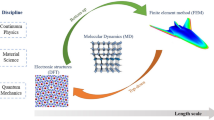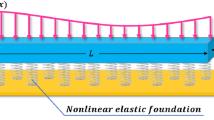Abstract
The alternating active-phase algorithm (AAPA) is widely recognized as being efficient for multi-material topology optimization. It has the advantages of easy implementation and broad applicability, but faces shortcomings, such as a uniform punishment intensity for all elements, excessive gray elements, and slow optimization convergence. To overcome these shortcomings, proposed here is an enhanced AAPA (EAAPA), the core ideas of which are as follows. (1) A new equal-scale Heaviside projection function (EHPF) is proposed, with the scale factor introduced to adjust the physical density adaptively to overcome the challenges of the invariance of the density sum and the uniqueness of projecting faced by the traditional Heaviside projection function. This adaptation reduces the number of gray elements and accelerates the convergence. (2) An innovative solid isotropic material with exponential sigmoid function (SIMESF) is constructed, with a penalty threshold and a steepness factor introduced to divide different penalty intensity regions and control their transition steepness. This improves the applicability and flexibility of the interpolation model, addressing the issue of a single punishment intensity in the solid isotropic material with penalization. The parameter values of the SIMESF model are explored via the design of a bridge, and the performances of AAPA and EAAPA are evaluated via the designs of simply supported and cantilever beams. The results show clearly that EAAPA has significant advantages in terms of optimization effectiveness and convergence speed.










Similar content being viewed by others
Abbreviations
- AAPA:
-
Alternating Active-Phase Algorithm
- EAAPA:
-
Enhanced Alternating Active-Phase Algorithm
- EHPF:
-
Equal-scale Heaviside Projection Function
- PEAAPA-S:
-
Partial EAAPA using SIMESF
- PEAAPA-H:
-
Partial EAAPA using EHPF
- RAMP:
-
Rational Approximation of Material Properties
- SIMESF:
-
Solid Isotropic Material with Exponential Sigmoid Function
- SIMP:
-
Solid Isotropic Material with Penalization
- TO:
-
Topology Optimization
References
Anaya-Jaimes L, Vicente W, Pavanello R (2022) Metamaterials design with a desired thermal expansion using a multi-material BESO method. Struct Multidisc Optim 65(12):355
Banh TT, Lee D (2018) Multi-material topology optimization design for continuum structures with crack patterns. Compos Struct 186:193–209
Banh TT, Lee D (2019) Topology optimization of multi-directional variable thickness thin plate with multiple materials. Struct Multidisc Optim 59:1503–1520
Bendse MP, Sigmund O (2004) Topology optimization. Theory, methods, and applications, 2nd edn. Springer, Cham
Bendsøe MP, Sigmund O (1999) Material interpolation schemes in topology optimization. Arch Appl Mech 69:635–654
Bourdin B (2001) Filters in topology optimization. Int J Numer Meth Eng 50(9):2143–2158
Bruns TE, Tortorelli DA (2001) Topology optimization of non-linear elastic structures and compliant mechanisms. Comput Methods Appl Mech Eng 190(26–27):3443–3459
Chen Y, Ye L, Xu C, Zhang Y (2021) Multi-material topology optimisation of micro-composites with reduced stress concentration for optimal functional performance. Mater Des 210(110):098
Cheng C, Yang B, Wang X, Long K (2022) Reliability-based topology optimization using the response surface method for stress-constrained problems considering load uncertainty. Eng Optim. https://doi.org/10.1080/0305215X.2022.2134357
Cheng Y, Ce L, Han D, Cunfu W, Zeyong Y (2023) Topology optimization of turbine disk considering maximum stress prediction and constraints. Chin J Aeronaut 36(8):182–206
Cui M, Yang X, Zhang Y, Luo C, Li G (2018) An asymptotically concentrated method for structural topology optimization based on the SIMLF interpolation. Int J Numer Meth Eng 115(10):1175–1216
Cui M, Zhang Y, Yang X, Luo C (2018) Multi-material proportional topology optimization based on the modified interpolation scheme. Eng Comput 34:287–305
Emmendoerfer H, Maute K, Fancello EA, Silva ECN (2022) A level set-based optimized design of multi-material compliant mechanisms considering stress constraints. Comput Methods Appl Mech Eng 391:114–556
Gao T, Zhang W (2011) A mass constraint formulation for structural topology optimization with multiphase materials. Int J Numer Meth Eng 88(8):774–796
Giele R, Groen J, Aage N, Andreasen CS, Sigmund O (2021) On approaches for avoiding low-stiffness regions in variable thickness sheet and homogenization-based topology optimization. Struct Multidisc Optim 64(1):39–52
Guest JK, Prévost JH, Belytschko T (2004) Achieving minimum length scale in topology optimization using nodal design variables and projection functions. Int J Numer Meth Eng 61(2):238–254
Habibian A, Sohouli A, Kefal A, Nadler B, Yildiz M, Suleman A (2021) Multi-material topology optimization of structures with discontinuities using peridynamics. Compos Struct 258(113):345
Han Z, Wei K, Gu Z, Ma X, Yang X (2022) Stress-constrained multi-material topology optimization via an improved alternating active-phase algorithm. Eng Optim 54(2):305–328
Hederberg H, Thore CJ (2021) Topology optimization for fail-safe designs using moving morphable components as a representation of damage. Struct Multidisc Optim 64(4):2307–2321
Huamaní DC, Gomes FA (2023) An alternating active-phase algorithm for multi-material topology optimization. J Braz Soc Mech Sci Eng 45(1):27
Huang X, Li W (2021) A new multi-material topology optimization algorithm and selection of candidate materials. Comput Methods Appl Mech Eng 386(114):114
Jung Y, Lim S, Kim J, Min S (2019) Lightweight design of electric bus roof structure using multi-material topology optimisation. Struct Multidisc Optim 61(6):1273–1285
Park J, Sutradhar A (2015) A multi-resolution method for 3D multi-material topology optimization. Comput Methods Appl Mech Eng 285:571–586
Sigmund O, Torquato S (1997) Design of materials with extreme thermal expansion using a three-phase topology optimization method. J Mech Phys Solids 45(6):1037–1067
da Silveira OAA, Palma LF (2022) Some considerations on multi-material topology optimization using ordered SIMP. Struct Multidisc Optim 65(9):261
Stolpe M, Svanberg K (2001) An alternative interpolation scheme for minimum compliance topology optimization. Struct Multidisc Optim 22:116–124
Sun Z, Song Z, Song J, Li H (2022) Structural optimization of fiber-reinforced material based on moving morphable components (MMCs). Acta Mech Solida Sin 35(4):632–646
Svanberg K (2007) MMA and GCMMA-two methods for nonlinear optimization, versions september 2007. Technical report, Optimization and Systems Theory, p 1
Tavakoli R, Mohseni SM (2014) Alternating active-phase algorithm for multimaterial topology optimization problems: a 115-line MATLAB implementation. Struct Multidisc Optim 49:621–642
Thomsen J (1992) Topology optimization of structures composed of one or two materials. Struct Multidisc Optim 5(1–2):108–115
Wang F, Lazarov BS, Sigmund O (2011) On projection methods, convergence and robust formulations in topology optimization. Struct Multidisc Optim 43:767–784
Wang Y, Luo Z, Kang Z, Zhang N (2015) A multi-material level set-based topology and shape optimization method. Comput Methods Appl Mech Eng 283:1570–1586
Xia Q, Shi T (2019) Generalized hole nucleation through BESO for the level set based topology optimization of multi-material structures. Comput Methods Appl Mech Eng 355:216–233
Xu S, Cai Y, Cheng G (2010) Volume preserving nonlinear density filter based on heaviside functions. Struct Multidisc Optim 41:495–505
Xu S, Liu J, Zou B, Li Q, Ma Y (2021) Stress constrained multi-material topology optimization with the ordered SIMP method. Comput Methods Appl Mech Eng 373(113):453
Yin L, Ananthasuresh G (2001) Topology optimization of compliant mechanisms with multiple materials using a peak function material interpolation scheme. Struct Multidisc Optim 23:49–62
Yoon G, Park YK, Kim Y (2007) Element stacking method for topology optimization with material-dependent boundary and loading conditions. J Mech Mater Struct 2(5):883–895
Yu L, Rong J, Tang C, Li F (2018) Multi-phase material struclural topology optimization design based on feasible domain adjustment. Hangkong Xuebao/Acta Aeronautica et Astronautica Sinica. https://doi.org/10.7527/S1000-6893.2018.22023
Zhao Z, Zhang XS (2021) Design of graded porous bone-like structures via a multi-material topology optimization approach. Struct Multidisc Optim 64:677–698
Zhou S, Wang MY (2007) Multimaterial structural topology optimization with a generalized Cahn–Hilliard model of multiphase transition. Struct Multidisc Optim 33(2):89–111
Zuo W, Saitou K (2017) Multi-material topology optimization using ordered SIMP interpolation. Struct Multidisc Optim 55:477–491
Acknowledgements
The authors would like to thank the anonymous reviewers for their valuable comments.
Funding
This work was co-supported by the National Natural Science Foundation of China (Grant Nos. 52005421 and 52305162), the National Science and Technology Major Project (Grant Nos. J2019-I-0013-0013 and J2019-IV-0011-0079), the Independent Innovation Foundation of AECC (Grant No. ZZCX-2018-017) and the project funded by the China Postdoctoral Science Foundation (Grant No. 2021T140634).
Author information
Authors and Affiliations
Corresponding author
Ethics declarations
Conflict of interest
The authors declare that they have no conflict of interest.
Replication of results
The datasets generated and analyzed during this study are available from the corresponding author upon reasonable request.
Additional information
Responsible Editor: Kai James
Publisher's Note
Springer Nature remains neutral with regard to jurisdictional claims in published maps and institutional affiliations.
Appendix: The impact of varied material ordering on optimization solutions
Appendix: The impact of varied material ordering on optimization solutions
This section uses the problem of steel and aluminum cantilever beam design from Sect. 4.2 as an example to investigate the impact of varied material ordering on optimization solutions employing different projection methods. Table 12 shows the optimization results obtained by EHPF and the traditional projection method (Method 2) in Sect. 3.1 when the material ordering changes. Rows two and three showcase optimization results using EHPF and Method 2 under the SIMP interpolation scheme when the material ordering for the entire problem is steel, aluminum, and void, respectively. Rows four and five depict results when the material ordering is aluminum, steel, and voids. According to Table 12, it can be observed that (1) Altering the material ordering significantly changes the structural compliance optimized using both projection methods, attributable to the inherent issue of material ordering dependency within the AAPA framework. (2) Under the same material ordering conditions, the structural compliance optimized using EHPF is relatively smaller. This is because Method 2 violates the requirement of uniqueness of the projecting and exacerbates the problem of material ordering dependency. Conversely, EHPF can overcome this issue, hastening convergence, and enhancing optimization effectiveness.
Rights and permissions
Springer Nature or its licensor (e.g. a society or other partner) holds exclusive rights to this article under a publishing agreement with the author(s) or other rightsholder(s); author self-archiving of the accepted manuscript version of this article is solely governed by the terms of such publishing agreement and applicable law.
About this article
Cite this article
Yan, C., Guo, H., Kang, E. et al. Multi-material topology optimization based on enhanced alternating active-phase algorithm. Struct Multidisc Optim 67, 73 (2024). https://doi.org/10.1007/s00158-024-03781-3
Received:
Revised:
Accepted:
Published:
DOI: https://doi.org/10.1007/s00158-024-03781-3




